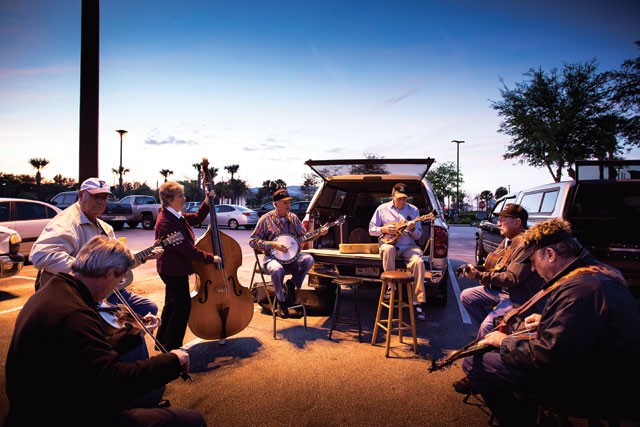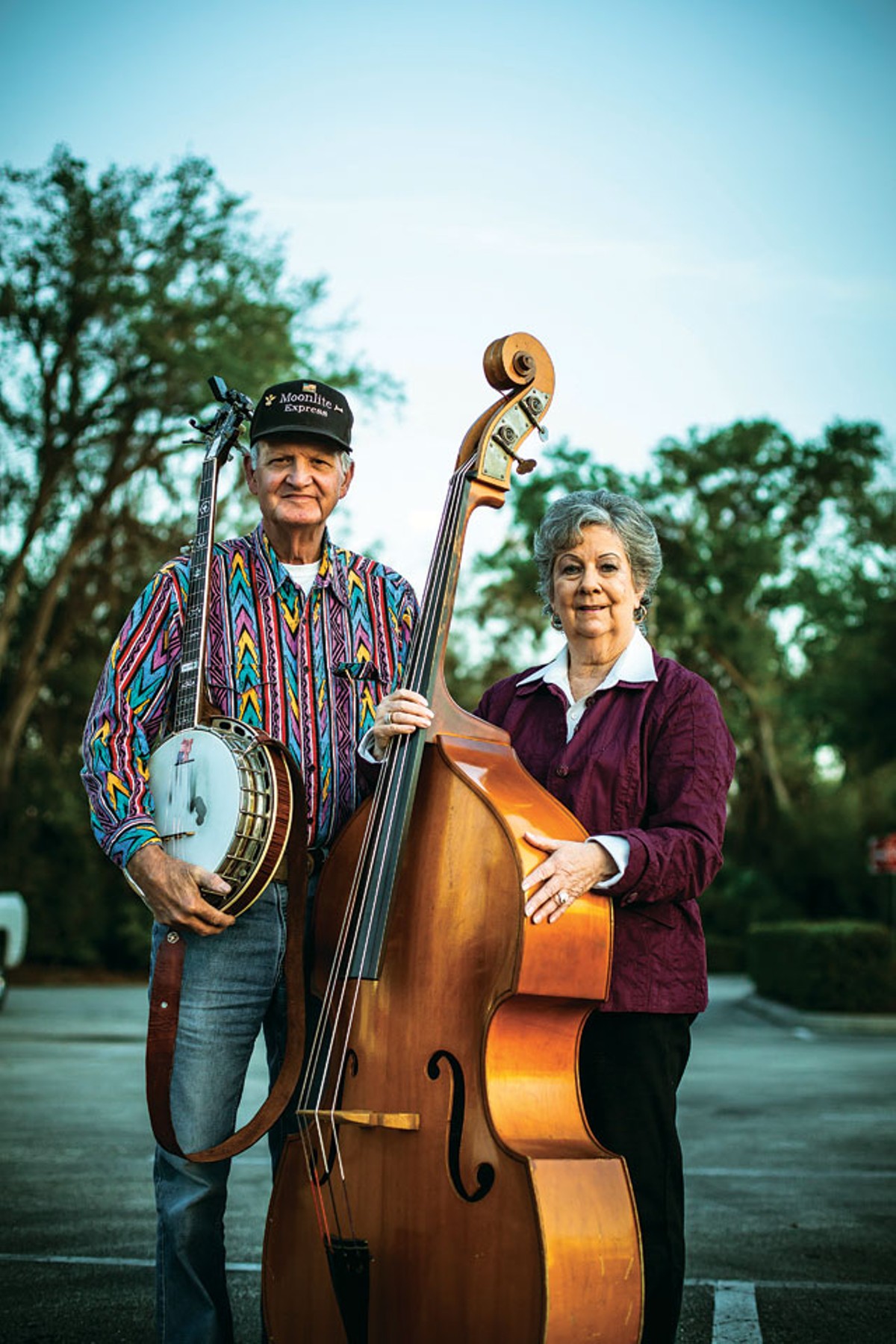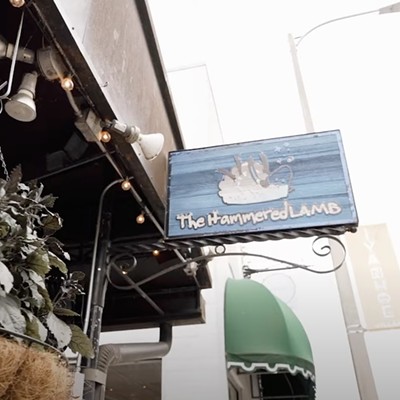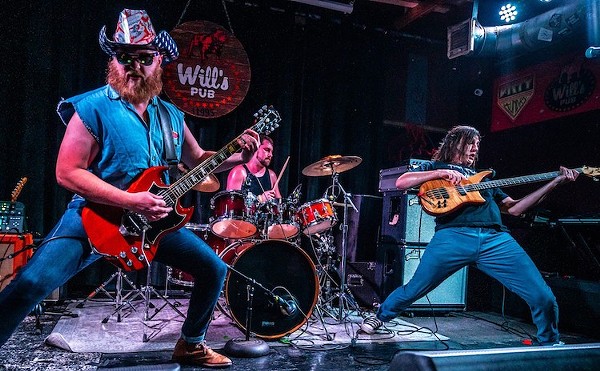The streetlights serve as the spotlights, and a row of classic cars acts as the backdrop as 72-year-old Jack Lewis sits perched on the tailgate of his pickup truck, plucking a banjo.
Every Friday night for the past 22 years, Lewis has sat in the same spot in this Ocoee parking lot, near the intersection of Route 50 and Maguire Road. And, just as it has for all of those years, a crowd builds around him as he plays – musicians with banjos and fiddles and guitars and mandolins and upright basses join him, spectators in folding chairs settle in for a show, curious passers-by stop to watch the unusual scene.
At Lewis' side is his 73-year-old wife, Judie. As he plays, she lends her vocals to a gang chorus on "Ruby (Are You Mad at Your Man)." It wasn't that long ago that she kept rhythm on many Friday nights on her standup fiddle. She says she's getting too old for that now, but she and Jack organize this weekly bluegrass jam – reportedly Florida's longest-running one – and she won't let her age stop her from coming out, even though it did insist that she stop playing fiddle.
In the halo surrounding these musicians, there's an equally devoted audience, sometimes 60 to 70 strong: a diverse array of older folks, families, the occasional stragglers who wander over from the nearby ice-cream stand that serves as the landmark to orient newcomers seeking out the event.
"Just head west on State Route 50 until you see the Twistee Treat," Jack Lewis tells people when asked for directions. "Don't worry. You'll see us."
If you don't see them, you'll probably hear them – when the group is in full swing, it's a complete bluegrass concert set right in the midst of this sprawling suburban strip mall.
The original flyer for this Friday night jam, which officially started in 1990, features a sketch of a guitar and a banjo crossed at their necks. A hastily scrawled message called out for anyone who wanted to play to show up at the Piggly Wiggly supermarket parking lot. That humble flyer was the beginning of something big for Jack and Judie Lewis. They'd played at theme parks, birthday parties, political gatherings – basically, anywhere they were invited to play. But the jam opened a whole new chapter in their lives, allowing them to stay intimately connected to the music that they love and the tradition that speaks to them.
Lewis has been active in the Florida bluegrass community for 37 years. Though it's true that you're more likely to stumble across a field of yellow wildflowers in Central Florida than the sea-green groundcover the music gets its name from, bluegrass music permeates our region. It's found in RV parks, spoil islands, fire stations and – occasionally – humble expanses of flattened blacktop.

Florida is also home to a wealth of annual bluegrass fests, many of which occur along the Suwannee River, one of the first places where the music, which originated in the late '30s, breached Florida's borders in the late 1950s. Radio shows like the Suwannee River Jamboree drew major bluegrass acts, like the Stanley Brothers, to Live Oak in Suwannee County, and later launched American bluegrass duo Jim & Jesse to commercial success. The momentum the music developed here was so great that even Bill Monroe, often called the father of bluegrass music, was drawn to visit our state. It actually was while visiting Live Oak that Monroe spied an unusual mandolin for sale in a barbershop window, according to Bill Monroe biography Can't You Hear Me Callin'. Monroe bought it – a 1923 Gibson F-5 Master model mandolin built by Lloyd Loar, now known as country music's most famous instrument – and adapted it to his own musical style. It was on this mandolin that Monroe hit his most inventive streak and forever changed the audible impact of acoustic string bands. Before Monroe, mandolins of this high quality were used only in the context of orchestras. But when classical music fell out of favor with audiences who had fallen hard for Elvis Presley's brand of rock & roll, the sophisticated instruments were discarded by many musicians. They were eagerly purchased by bluegrass pickers who previously couldn't afford them.
Monroe is long dead, but his legacy and his influence on bluegrass music persists. Lewis' informal group follows his lead – all acoustic, no electric.
"Bill Monroe refused to go electric," Lewis says. "Like him, we play all acoustic instruments. To amplify, we play into a microphone – not plugged into your instrument, now, but played into."
Lewis was a latecomer to bluegrass music – he first encountered it at 35, when his musically minded mother played an Earl Scruggs record for him one day. Up until that point, Lewis says he was an Elvis fan, but when the record finished, he immediately asked her to play it again. Scruggs, who's known for perfecting the three-finger banjo-picking technique, won him over, and Judie set to work putting a banjo into her husband's hands – an old cheapie, she says. Then Jack got to work learning to play it, a mission that led to obsession.
"When I was learning, I didn't have anybody to show me anything," he says. "I'd listen to those old LP albums, you know, back when they had long-play albums, and I would listen to those and try to copy what I heard. That's the way I taught myself, so I missed out on a lot, not knowing how to do the proper way, but then everybody says you don't want to do it exactly like Earl Scruggs because then there'd be two Earl Scruggs in the world."
Scruggs passed away almost a year ago, robbing the bluegrass world of its most innovative and influential banjo player. But for all those who admired and learned from him, the best way to preserve his memory was to simply keep on picking and honoring the music. Which is what Lewis and his fellow bluegrass lovers do every week in Ocoee.
To get a better idea of how treasured bluegrass is in Florida, you can trek out to MagnoliaFest, Palatka Bluegrass Festival, Florida State Bluegrass Festival or dozens of nearby events where visitors can catch casual jam sessions, regionally loved acts like Grandpa's Cough Medicine and big-bill performances by imported icons like Emmylou Harris. Large crowds assemble and camp out for days in these overnight bonded-by-bluegrass communities. Fast approaching is the Fort Christmas Bluegrass Festival, which takes place March 16-17. You'll find Jack and Judie there, too – their band, Moonlite Express, performs there every year, just as they've appeared at similar festivals for the past quarter of a century. And they've turned out as fans for even longer than that.
When they were younger, Jack was a raving diehard fan of the music, and Judie was just along for the ride. She'd knit or read magazines while Jack chased the sound all over the state. That changed, though, when a family from Kentucky appeared at the Ocoee Parking Lot Bluegrass Jam one Friday night. The daughter played the lead on several songs on the upright bass. It was something Judie hadn't seen before, and it inspired her. So Jack taught her to play, she joined Moonlite Express, and she grew into a capable backbone for the group.
When the sessions first started out, Jack Lewis says, Moonlite Express acted as the core of the group, never missing a Friday night.
"A lot of people didn't know how to pick good, and they'd come up and stand around the fringes," he says. "We'd just more or less kind of keep it running, you know? We'd sing a song or two and encourage people to play and sing, and there's some good pickers, bad pickers, but it was all meant to have a good time."
As time has gone by, though, the jam has gained a reputation. It's received so much attention that people have traveled from different states, and even other countries, to pick along with the Moonlite Express and the crew of regulars. Lewis doesn't operate a website, and the jam isn't advertised, so people have to find out about it through word of mouth. Or, perhaps, from the more than 100 high-quality videos found on the YouTube account run by a user named "vivatones66." The videos capture the magnetism and energy of the event and have amassed 136,911 views at the time of this writing. The jam is also well-documented on niche bluegrass sites that track similar events around the world, and it's easily discoverable by a quick Google search. But, as Lewis points out, the jam's been around longer than Google and much longer than YouTube. Its staying power is due mostly to its reputation, and the level of talent on certain nights is baffling, even to Jack.
"If you go out there enough, you'll see some banjo players out there that put me to shame," Lewis says. "But, they're a lot younger than me, and they remind me of me when I was their age. It doesn't bother me – I mean, we're all just out there to have fun."
Although the stalwarts of bluegrass music (and the Ocoee jam) are getting up there in age and taking their leave from this lonesome-sounding life, lots of newer musicians have embraced bluegrass. They've adopted and adapted the sound, introducing it to younger audiences. For instance, comedian Steve Martin is a banjo player and has put together a band called the Steep Canyon Rangers, who have several Grammy-nominated recordings. Martin also narrates the 2011 documentary Give Me the Banjo (streaming on Netflix). Contemporary rock and alt-country musicians, like the Avett Brothers and the Old Crow Medicine Show, have popularized the sound and brought it to an entirely new generation. Then there are modern bands, like Pokey LaFarge's, who dig deep into the rootsy sounds of hillbilly music to reproduce the traditional elements that define country and bluegrass – stuff you'd experience on The Grand Ole Opry in the days of Monroe.
Likewise, the Ocoee jam attracts both young and old pickers and fans. Each week brings new faces, new players, new songs and new reasons for it to keep going. When asked whether he thinks the jam will continue even when he's no longer able to make it out every Friday night, Lewis isn't exactly sure how to answer. What he can say is that nobody expected it to go on for this long. And yet, it does.
The bond between Jack and Judie Lewis is actually somewhat striking in the context of bluegrass music, since much of it hinges thematically on loneliness and sorrow. Monroe, who was a womanizer and an outcast for much of his life, defined the music in a unique way. He juxtaposed happy, busy melodies with dark lyrics that synthesized how difficult it can be for a troubled mind to mitigate feelings of depression and isolation in a chaotically upbeat world. That pain has driven many a crooner to bemoan in song, "No one knows me, no one seems to care."
In an early 1940 song, "Tennessee Blues," Monroe's only salvation was seclusion; "I'd find me a spot on some mountain top with no one around me," he sang. Most everyone is familiar with the bluegrass classic "Orange Blossom Special." Though the song is famously upbeat as performed by artists like Johnny Cash, it's actually about a man who expects to die before he ever returns to the home he loves. Even instrumental bluegrass songs, like Doc Watson's "Windy and Warm," evoke the wistful conclusion that this life we walk through is not a shared stroll.
But perhaps the painful place that bluegrass music constantly refers to is actually what draws people like Jack and Judie together. Nobody really wants to be alone. And that fear of loneliness and isolation may also be why the music keeps bringing people together from near and far to fests and jams, like the one that's been drawing people out to Ocoee for two full decades.
"See, when we started the jam, it wasn't just an open-to-the-public, anybody can come in and pick," Jack says. "What we were looking for was just about six or seven or eight people that we'd pick with all the time, and we just needed a place to get to, somewhere to gather up. And that's what it was intended to be, but then people would drive by, and they'd see us, and maybe they picked a little, so they stopped and said, 'Hey can I join in?' You know, yeah! We didn't mind."



















